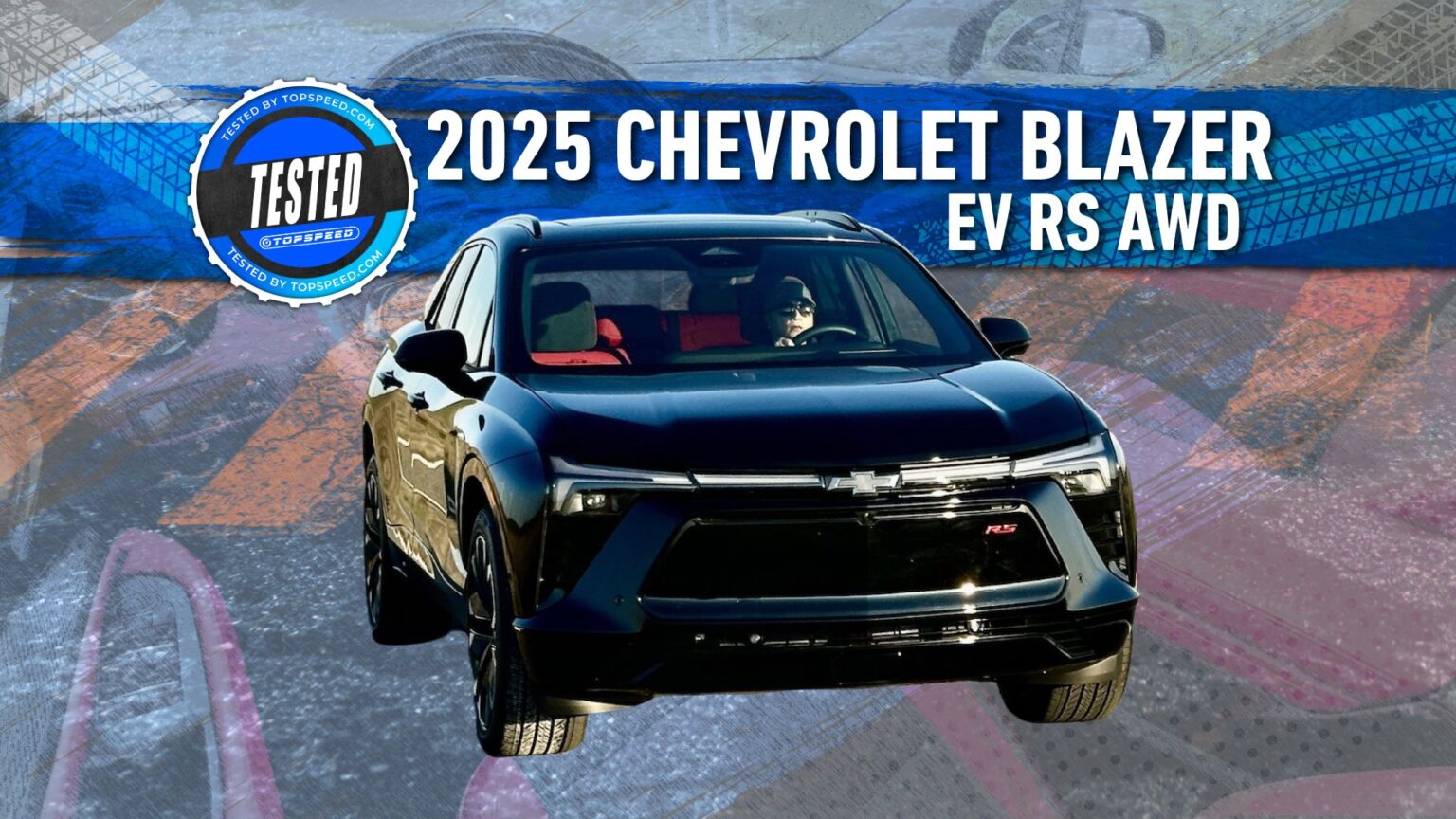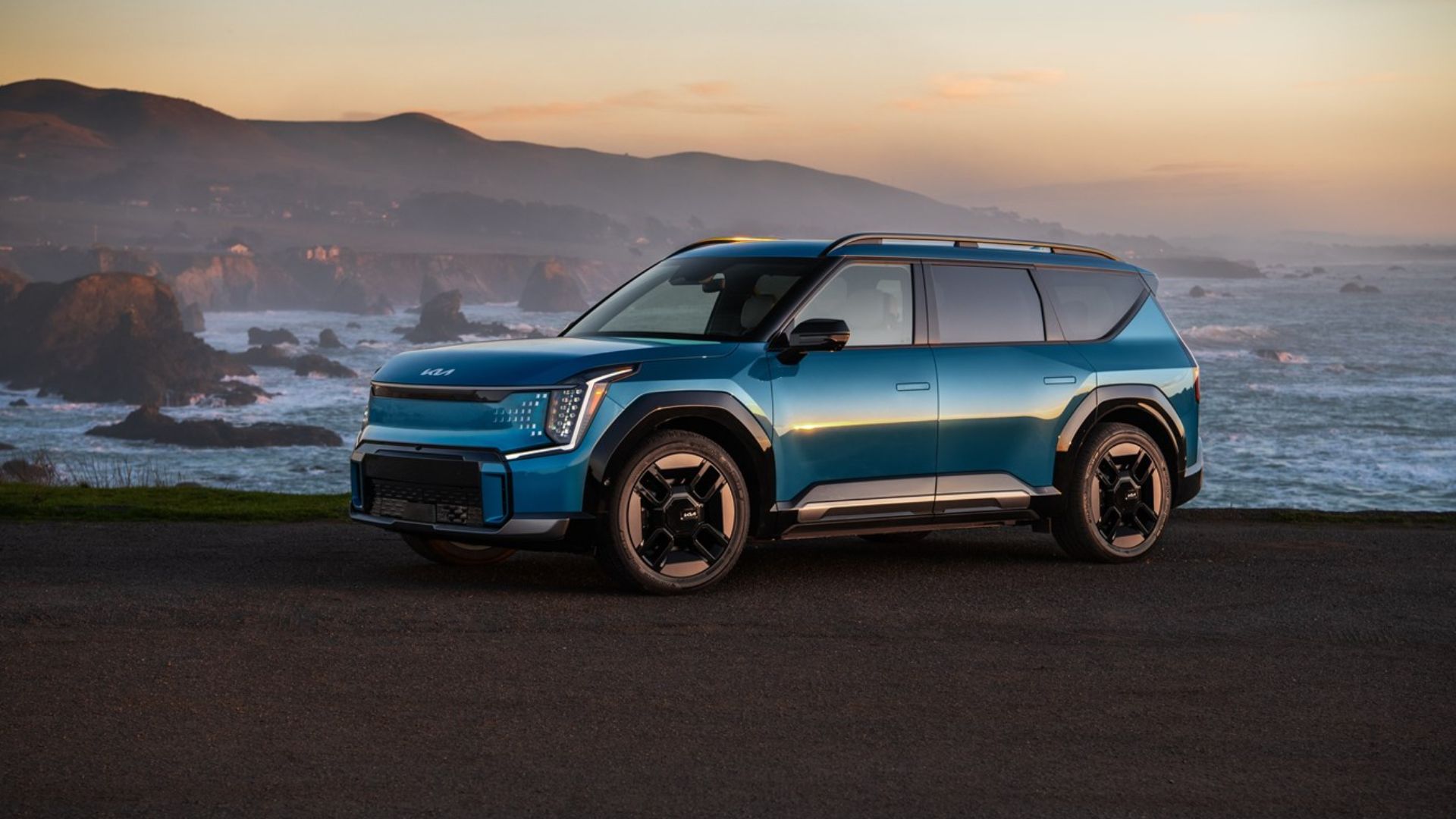There was a time when the Chevrolet Blazer was closer in design to Ford’s Bronco than its Mustang Mach-E as it is today. Thus, many of you with longer-than-average memories may be surprised to learn the now-defunct Camaro inspired the styling of today’s Blazer, which was resurrected in 2019 after a ten-year hiatus. In other words, that Mustang Mach-E comparison was more astute than you may have at first realized. What’s more, like the Mach-E, the model we’re looking at here, the 2025 Chevrolet Blazer EV RS AWD, garners its motivation from electrons, rather than petrochemicals, as did its ancestors. And, its appearance is far more distinctive than that of its forebears.
However, size and pricing prevent the Blazer and Mustang Mach-E from being direct competitors. The Mustang is closer to Chevy’s smaller Equinox in both regards. That said, the Blazer EV’s pricing starts at $52,900, while the price as tested for the RS AWD example I drove is $60,375.
In order to provide you with an honest and unbiased review, I drove the vehicle reviewed in this article on a daily basis throughout the course of daily life for a period of one week. For detailed insight into testing procedures and data collection, please review our methodology policy.
2025 Chevrolet Blazer EV RS AWD First Impressions
To a person, everyone with whom the Blazer and I came into contact over the course of my week in the electrified crossover SUV commented on the appealing nature of its styling. Rendered in Jet Black over the reddest leather I have ever seen in my life, “my” Blazer was an absolute standout. Poised on a set of 21-inch wheels, which were framed by muscular wheel arches, the Blazer’s appearance also radiated performance potential.
Where most vehicles go with black for stealth, the onyx-like finish made the Blazer the center of attention instead. More than a few of my neighbors stopped dead in their tracks to ask about its provenance. And, to a person, they were all surprised to learn it was a Chevrolet and an EV besides.
Exterior Dimensions
|
Length |
192.23 Inches |
|
Width |
78.02 Inches |
|
Height |
65 Inches |
|
Wheelbase |
121.8 Inches |
|
Front Track |
65.9 Inches |
|
Rear Track |
65.9 Inches |
|
Curb Weight |
5,236 Pounds |
Driving Impressions And Performance
A product of GM’s Ultium platform, as the window sticker proudly asserted, the 2025 Chevrolet Blazer EV RS AWD used a pair of electric motors, one for each set of drive wheels. Total system output was listed at 300 horsepower and 355 pound-feet of torque. While those numbers hold the promise of exhilarating performance, it’s important to bear in mind the AWD Blazer EV has a curb weight of 5,236 pounds.
As a result, the most apt descriptor of the Blazer’s acceleration would be “sufficient”. The Blazer wasn’t slow, but it wasn’t really fast either. True velocity is reserved for the 615-horsepower AWD Blazer EV SS. Ultium-ately (see what I did there?) I saw six-second zero to 60 runs. While I didn’t try to top it out, as I was driving on public roads, the folks at Chevrolet say the Blazer EV RS AWD is good for a terminal velocity of 130 mph.
While you might expect that 5,200-pound curb weight to negatively impact handling, it was quite the opposite. The Blazer EV felt quite agile, albeit with a mild degree of body roll in the turns. The brakes were more than powerful enough, and the Blazer EV supported one-pedal driving. Get your timing right, and you’ll seldom have a need for the “other” pedal. Just let off the throttle gradually and the Blazer will come to a stop. Be careful though; letting off the throttle abruptly will trigger a disconcerting lurch.
Ride quality was comfortable in all circumstances, but you won’t go screaming along mountain roads with ease. Managed adeptly though, the Blazer EV RS AWD offered an entertaining degree of proficiency. It was also quiet, as Chevy’s engineering team managed to keep wind noise to a minimum.
Performance Specifications
|
Motor Setup |
Permanent magnet, bar-wound (front) and induction motor without magnet (rear) |
|
Transmission |
Single-Speed |
|
Horsepower |
300 HP |
|
Torque |
365 LB-FT |
|
Battery Chemistry |
Lithium-ion NCMA cathode, blended graphite anode |
|
Battery EVs/Hybrids only |
85 kWh Net |
|
Fuel Economy (CMB) |
95 MPGe – EPA Estimate |
|
0-60 MPH |
Six Seconds |
|
Top Speed |
130 MPH – Estimated |
|
Towing Capacity |
1,500 Pounds |
Chevrolet Blazer EV RS AWD Fuel Economy
The EPA estimates a fuel economy rating of 95 MPGe combined, 102 in the city and 87 on the highway. The Blazer EV AWD is also said to consume 36 kWh per 100 miles. A full charge is estimated to take the EV RS AWD Blazer 283 miles. Driving conservatively, I got pretty close—275.
Charge time from full depletion is an estimated 9.5 hours using a 240V source. I saw a gain of 56.1240 kWh in 83 minutes using an EVgo 350kw DC charging station. That came out to just under 200 miles of range for $39.72 USD.
|
City |
Highway |
Combined |
|
|
EPA Rated Economy |
102 MPGe |
87 MPGe |
95 MPGe |
|
Range As Tested |
275 Miles |
Interior Design And Comfort
You think you’ve seen red? You haven’t come even close until you’ve had your retinae seared by Chevrolet’s Adrenaline Red leather interior package. Although I do have to admit, while it was quite jarring at first glance, I kinda started liking it after a few days—let’s just call it a guilty pleasure. It reminded me of the good old days when interiors were far more colorful than they are today, when nearly every passenger compartment is rendered in some shade of beige, gray, or black.
The interior’s architecture added another element of interest. Five generously sized HVAC outlets (trimmed in red—of course) competed with the extra-wide video display for my initial attention. A row of physical buttons positioned just below the infotainment screen dictated the functioning of the HVAC system.
Fit and finish, as well as the materials choices, were quite good. Yes, there were some hard plastics in play. Strategically placed though, they didn’t clamor for undue attention. Seating comfort was good at all four primary positions, as well as in the center rear seat. Second-row passengers were also afforded their own pair of air vents. Rear outboard seating positions were heated too. There was no third row, but that enhanced cargo capacity. All in all, I found the interior of the 2025 Chevrolet Blazer EV RS AWD to be a pleasant place from which to watch the world go by.
Interior Dimensions
|
Front |
Rear |
|
|
Headroom |
40.9 Inches |
38.1 Inches |
|
Shoulder Room |
58.7 Inches |
58.3 Inches |
|
Hip Room |
57.4 Inches |
53.8 Inches |
|
Legroom |
44.2 Inches |
38.9 Inches |
Technology And Ease Of Use
Some 28 inches of digital display dominated the dash treatment. The lion’s share of that housing was devoted to infotainment. Meanwhile, the 11-inch screen positioned behind the steering wheel monitored the Blazer’s vital functions. It should be noted the infotainment system eschews both CarPlay and Android compatibility.
However, it does have Google built in. While this helps it supply ready access to applications such as Google Maps, Spotify, and Waze, you’ll rely on hard-wiring, or a Bluetooth connection for streaming audio from your mobile device. The Blazer’s native GPS function offered charging station suggestions along a programmed route. It also gave me an estimate of the amount of range I’d have in the battery pack when I reached the destination. A wireless smartphone charging pad was fitted to my test car, as well as a generous array of USB ports. The former included a pair at the rear of the center console for passengers occupying the back seat.
Cargo And Storage Space
The primary cargo area supplied 26 cubic feet of carrying capacity. When I folded the rear seats away, that figure jumped to a generous 60 cubic feet. As is standard practice these days, the rear seatbacks offer a 2/3 and 1/3 split folding capability, with the right side being the smaller of the two.
The cargo floor was flat when both sides were folded. This made loading and unloading the compartment easier to accomplish. As is to be expected, the usual array of door pockets and cupholders were supplied, along with center console storage and a generously proportioned glove box up front.
|
Minimum Cargo Capacity |
26 Cubic-Feet |
|
Cargo Capacity Second-Row |
60 Cubic-Feet |
2025 Chevrolet Blazer EV RS AWD vs. Its Competitors
Blazer’s closest EV competitors are the 2025 Kia EV9 and the 2025 Honda Prologue. Going into its third year of production, Kia’s EV9 is a formidable competitor. In fact, many pundits consider it the benchmark in this range. Meanwhile, Honda’s Prologue is—for all intents and purposes—a Blazer in disguise. The two models resulted from an engineering partnership between General Motors and Honda.
How The Chevrolet Blazer Compares To The Kia EV9
Kia’s EV9 enjoys universal acclaim, thanks to its looks, comfort, and functionality. The Kia also offers three rows of seating, whereas the Blazer makes do with three. And, of course, being a Kia, the EV9 is also equipped like it’s a far more expensive vehicle than it is.
All-wheel-drive versions of the Kia enjoy 379 horsepower, compared to the Blazer’s 300. A full charge is said to be capable of taking AWD EV9 models some 280 miles. The Kia’s 800-volt architecture gives it the capability of gaining 100 miles of range in 13 minutes, with an average charging speed of 139 kilowatts from a 10 to 90 percent state of charge.
How The Chevrolet Blazer Compares To The Honda Prologue
Because the Honda and the Chevy were co-developed, there is a great deal of mechanical similarity between the Prologue and the Blazer. Much of the interior switchgear is also the same. However, the Honda’s overall design is more conservative than the Chevrolet’s.
On the other hand, you can get CarPlay/Android compatibility, which isn’t offered with the Blazer. All-wheel-drive Prologues are said to be good for 281 miles of range, unless you go for the fully loaded Elite trim package, in which case you’ll make do with 273. Additionally, where the Kia offers a 230 kW DC fast charging speed, the Prologue can only handle 155 kW, so the Kia charges considerably faster.
Our Recommendation For Which Model You Should Buy
As much as I like the look of the Blazer, there are a number of reasons the Kia EV9 tops this category. It’s more spacious, offers a third row of seats and is faster. What’s more, the EV9 charges more quickly than both the Chevrolet and the Honda—and offers more range. The Kia is also more roomy for passengers and cargo. Long story short, if you’re objectively cross-shopping between these three, the Kia is a better buy, even though it costs a bit more. Now, with that said, the Blazer does have a number of distinctions going for it. If you came to this review because you like the 2025 Chevrolet Blazer ES RS AWD, and were hoping you wouldn’t find a reason to not get one, go ahead and treat yourself. Getting a Blazer EV won’t ruin your life.
Read the full article here



